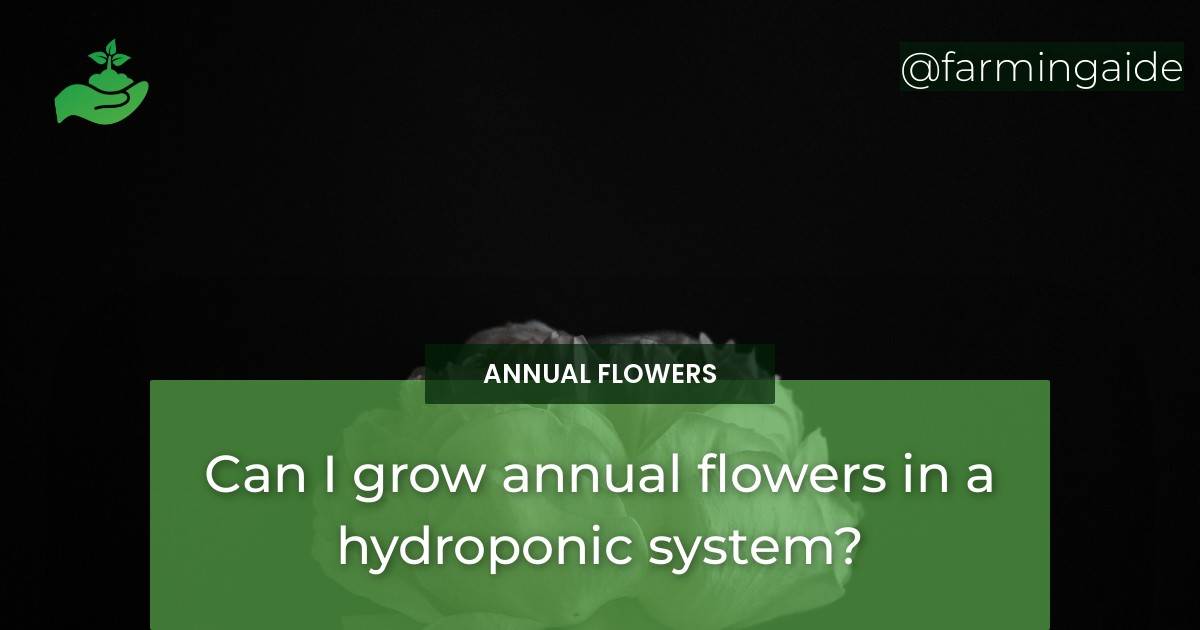Yes, you can grow annual flowers in a hydroponic system. Hydroponic systems provide an ideal environment to grow plants without the use of soil. Annual flowers are those that complete their life cycle within one year and include marigolds, zinnias, and petunias. Hydroponic systems offer several advantages over traditional soil-based gardening, such as increased yield, controlled nutrient intake, reduced water usage, consistent quality, pest control, and extended growing season. However, there are also some disadvantages to consider, such as high initial setup costs, technical knowledge requirements, vulnerability to power outages, and limited crop selection.
Advantages and Disadvantages of Growing Annual Flowers in Hydroponic Systems
Advantages
Hydroponic systems can boost the growth and yield of annual flowers. Some of the advantages of growing annual flowers in a hydroponic system include:
- Increased yield due to the optimal growing environment with proper nutrient and lighting conditions.
- Controlled nutrient intake, which allows for fine-tuning of nutrient levels, leading to more robust annual flowers.
- Reduced water usage as the hydroponic system recirculates water, using only a fraction of the water required in traditional soil-based gardening.
- Consistent quality, with each plant receiving the same amount of nutrients and water, leading to uniform growth and flower production.
- Pest control, as hydroponic systems are closed environments with fewer pests and diseases, reducing or eliminating the need for pesticides.
- Extended growing season, as hydroponic systems can be set up indoors and controlled year-round, providing a consistent supply of annual flowers.
Disadvantages
While hydroponic systems offer several advantages, there are also some disadvantages to consider:
- High initial setup cost as hydroponic systems require specialized equipment and technology to operate.
- Requires technical knowledge as the system needs to be monitored and adjusted regularly to ensure optimal growing conditions.
- Vulnerable to power outages as the hydroponic system relies on electricity to function, which can be disrupted during power outages.
- Limited crop selection, as not all annual flowers are suitable for hydroponic systems, limiting the variety of plants that can be grown.
Techniques for Growing Annual Flowers in Hydroponic Systems
Hydroponic Setup Considerations
When setting up a hydroponic system for annual flowers, several factors need to be considered:
- Choosing the right system, such as a deep water culture, nutrient film technique, or ebb and flow system, depending on the size of the space and the number of plants.
- Lighting considerations, as annual flowers require sufficient light to grow and flower, and different types of lights are available depending on the stage of growth.
- Temperature and humidity control, as the hydroponic system needs to maintain optimal growing conditions for the annual flowers to thrive.
- Air circulation, as proper air movement is necessary to prevent issues such as mold growth and excess humidity.
- Water quality, as hydroponic systems require clean, pH-balanced water to ensure the plants receive the nutrients they need.
Nutrient Requirements for Annual Flowers
Annual flowers have specific nutrient requirements that must be met to grow and flower successfully. Essential nutrients for growth include nitrogen, phosphorus, and potassium, among others. Nutrient delivery methods can vary, such as using a premixed solution or a custom blend of nutrients. Monitoring and adjusting nutrient levels regularly can help ensure optimal growth and flowering.
ALSO READ
Choosing the Right Annual Flowers for Hydroponic Systems
When selecting annual flowers for hydroponic systems, several factors should be considered:
- Growth characteristics, such as the size of the plant and the length of time to maturity.
- Light and temperature requirements, as different annual flowers have varying needs for light and temperature.
- Flower type, as some annual flowers produce more abundant flowers than others.
Some of the best annual flowers for hydroponic systems include petunias, marigolds, and zinnias. Recommended cultivars for hydroponic systems include ‘Titan Red’ marigold, ‘Profusion Orange’ zinnia, and ‘Supercascade Red’ petunia.
Maintaining Hydroponic Systems for Annual Flowers
Common Issues and Solutions
Like any growing system, hydroponic systems can experience issues such as nutrient deficiencies, pest infestations, pH imbalances, and algae growth. Some common solutions include:
- Identifying and correcting nutrient deficiencies by adjusting nutrient levels.
- Using natural pest control measures such as beneficial insects or organic pesticides.
- Adjusting pH levels to maintain a pH range of 5.5-6.5 for most annual flowers.
- Reducing light exposure to control algae growth and prevent it from clogging the system.
General Maintenance Tips
Regular maintenance of the hydroponic system is necessary to ensure its optimal functioning. Some general maintenance tips include:
- Regular cleaning to prevent the buildup of debris and bacteria.
- System inspections to identify and correct issues before they become major problems.
- Water and nutrient replenishment to ensure plants receive proper nutrients and water.
- Crop rotation to prevent soil-borne diseases and nutrient depletion.
Harvesting and Storage of Annual Flowers Grown in Hydroponic Systems
The optimal time to harvest annual flowers depends on the type of flower and the intended use. Post-harvest handling techniques such as trimming and cooling can improve the quality and longevity of the annual flowers. Storage recommendations include keeping the annual flowers at cool temperatures, away from direct sunlight and ethylene-producing fruits and vegetables.
Can Annual Flowers Thrive in Different Growing Environments Such as Hydroponic Systems and Xeriscape Gardens?
Yes, annual flowers can thrive in different growing environments such as hydroponic systems and xeriscape gardens. When it comes to growing annual flowers in xeriscape gardens, it’s important to choose drought-tolerant plants that can withstand low water conditions and still flourish beautifully in that environment.
Conclusion
Growing annual flowers in a hydroponic system provides several advantages, including increased yield, controlled nutrient intake, reduced water usage, consistent quality, pest control, and extended growing season. However, there are also some disadvantages to consider, such as high initial setup costs, technical knowledge requirements, vulnerability to power outages, and limited crop selection. By following proper techniques for growing, maintaining, and harvesting annual flowers in a hydroponic system, gardeners can enjoy a consistent supply of beautiful flowers year-round.


